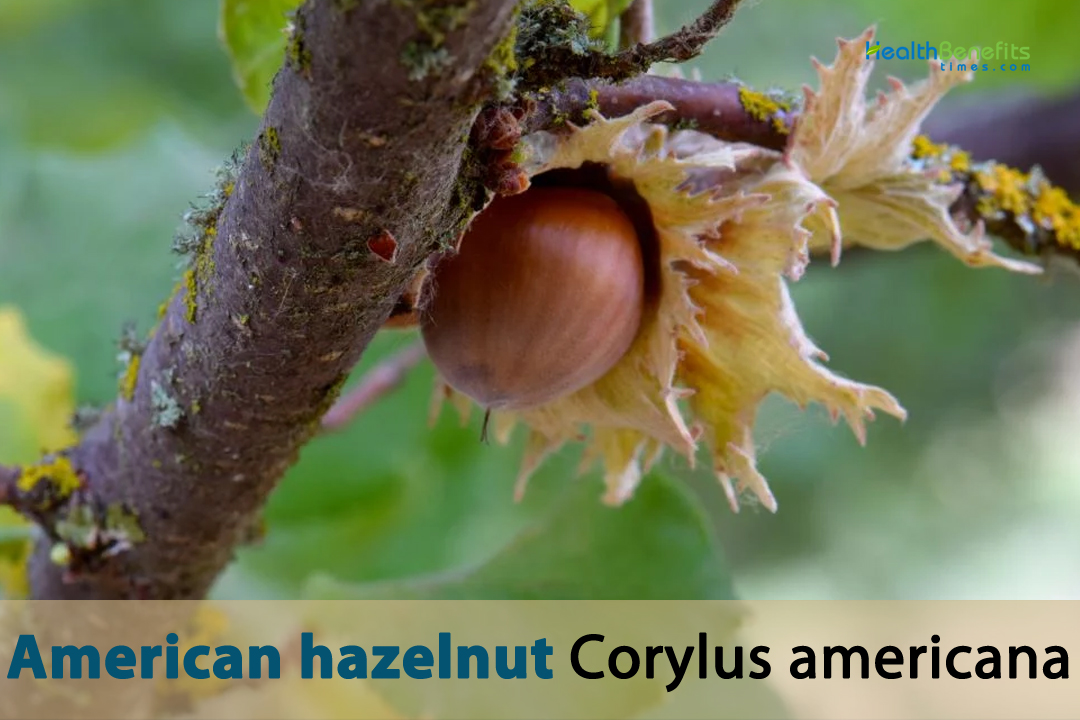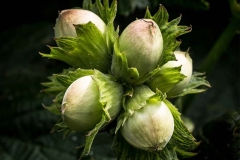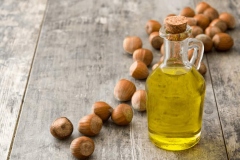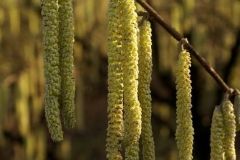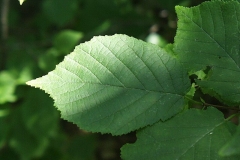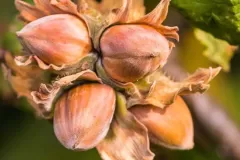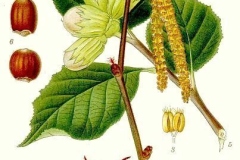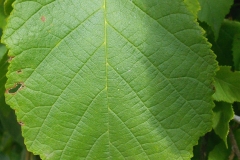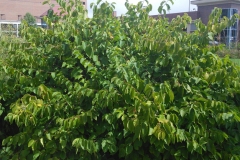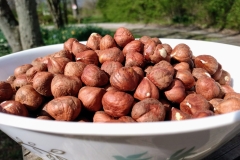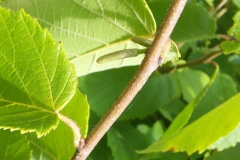| American hazelnut Quick Facts | |
|---|---|
| Name: | American hazelnut |
| Scientific Name: | Corylus americana |
| Origin | Eastern North America, Maine west to Saskatchewan and North Dakota, south to eastern Oklahoma, Arkansas, and Georgia |
| Colors | Brownish to reddish-brown when they mature |
| Shapes | Acorn-like nut 1-2 cm long, wider than long |
| Taste | Mild and slightly sweet |
| Major nutrients | • Healthy Fats • Protein • Fiber • Vitamin E • Vitamin B6 • Vitamin B9 • Vitamin B3 • Manganese • Copper • Magnesium • Antioxidants • Phytosterols |
| Health benefits | Good for fevers, hives, tumors, constipation, biliousness, diarrhea, cramps, hay fever, childbirth, hemorrhages, prenatal strength, teething, induction of vomiting, and wound healing |
| Name | American hazelnut |
|---|---|
| Scientific Name | Corylus americana |
| Native | Eastern North America, Maine west to Saskatchewan and North Dakota, south to eastern Oklahoma, Arkansas, and Georgia, not found along the Gulf coast region |
| Common Names | American hazelnut, American cobnut, Beaked hazelnut, Smoothleaf hazelnut, Western hazelnut, Wild hazelnut, Common hazel, Eastern hazelnut, Low hazelnut, Fencerow hazel, Smooth hazelnut, American filbert, Wild filbert, Prairie hazel, Lowbush hazelnut |
| Name in Other Languages | Afrikaans: Amerikaanse haselnoot Arabic: Bunduq Amriki (بندق أمريكي) Armenian: Amerikyan hauştali (Ամերիկյան հաուստալի) Assamese: American Hazelnut Azerbaijani: Amerikan fındığı, Amerikan laləsi Bengali: American Hazelnut (আমেরিকান হেজেলনাট) Bhojpuri: American Hazelnut (अमेरिकन हेजलनट) Bulgarian: Amerikanski leshnik (Американски лешник), amerikanska leska (американска леска) Chhattisgarhi: American Hazelnut (अमेरिकन हेजलनट) Chinese: Měiguó zhēnshù (美国榛树), Měizhōu zhēn (美洲榛) Croatian: Američki lesni orah Czech: Americký lískový ořech Danish: Amerikansk hassel Dutch: Amerikaanse hazelaar English: American hazelnut, Hazel, Hazelnut, American filbert, American hazel, Dwarf filbert Esperanto: Amerika korylo Estonian: Ameerika pähkel Filipino: Amerikanong hazelnut Finnish: Amerikanpähkinä, Amerikanpähkinäpensas French: Noisetier d’Amérique, Noisertier d’Amerique German: Amerikanische Haselnuss, Amerikanische Hasel, amerikanischer Haselnußstrauch, Bluthaselnußstrauch Georgian: American hazelnut Greek: Amerikanikó fountoúki (Αμερικανικό φουντούκι) Gujarati: Amerikan Hejalnat (અમેરિકન હેઝલનટ) Haryanvi: American Hazelnut (अमेरिकन हेजलनट) Hausa: American hazelnut Hebrew: Egoz Amerikai (אגוז אמריקאי) Hindi: Amerikan Hazelnut (अमेरिकन हेज़लनट) Hungarian: Amerikai mogyoró Icelandic: Bandarísk hasselnöt Indonesian: Hazel Amerika Italian: Nocciolo americano, Nocciuolo nano, Nocciuolo rostrato Japanese: Amerika-hashibami (アメリカハシバミ), Amerika hēzerunattsu (アメリカヘーゼルナッツ), Amerika no heezeru (アメリカのヘーゼル) Kannada: Amerikan Hejelnat (ಅಮೆರಿಕನ್ ಹೇಜಲ್ನಟ್) Kashmiri: American Hazelnut (امریکن هیزل نٹ) Kazakh: Amerïqalıq janar (Америкалық жанар) Konkani: American Hazelnut Korean: Miguk baeg-iltong (미국 백일통) Kumaoni: American Hazelnut (अमेरिकन हेजलनट) Kurdish: Amerîkî fındık Kyrgyz: Amerikalıq jalıw (Америкалык жалыуу) Lithuanian: Amerikinis lazdynas Latvian: Amerikāņu lazda Maithili: American Hazelnut (अमेरिकन हेजलनट) Malay: Hazel Amerika, Hazelnut Amerika, American hazelnut Malayalam: Amerikan Heselnatt (അമേരിക്കൻ ഹേസൽനട്ട്) Manipuri: American Hazelnut, American Hazelnut (আমেৰিকান হেজেলনাট) Marathi: American Hazelnut (अमेरिकन हेजलनट) Mongolian: Amerikiin amidar (Америкийн амидар) Nepali: Amerikan Hezelnat (अमेरिकन हेजलनट) Norwegian: Amerikansk hassel Odia: American Hazelnut (ଆମେରିକାନ ହେଜଲନଟ) Polish: Orzech amerykański Portuguese: Avelã Americana, aveleira-americana Punjabi: Amarīkan hejalanaṭ (ਅਮਰੀਕਨ ਹੇਜਲਨੱਟ) Romanian: American hazelnut Russian: Amerikanskiy lesnoy orekh (Американский лесной орех), Leshchina amerikanskaya (Лещина американская) Sanskrit: (Amerikan hejalanat)अमेरिकन हेजलनट् Serbian: Američki lesni orah (Амерички лесни орах) Sindhi: American Hazelnut (امريڪين هيزل نٽ) Sinhala: Amerikāṉu hēsalanṭ (ඇමරිකානු හේසල්නට්) Slovenian: Ameriški lešnik Slovak: American hazelnut Spanish: Avellano americano Swahili: Karanga ya Amerika Swedish: Amerikansk hasselnöt, Amerikansk hassel, Hasselbuske Tajik: Fistoni amrikoī (Фистони амрикоӣ) Tamil: Amerikan Hesalnat (அமெரிக்கன் ஹேசல்நட்) Telugu: Amerikan Hejelnat (అమెరికన్ హేజల్నట్) Thai: Phrik kra rêīyngx ’emrikan (พริกกระเหรี่ยงอเมริกัน) Tulu: American Hazelnut (ಅಮೆರಿಕನ್ ಹೆಜೆಲ್ನಟ್) Turkish: Amerikan fındığı Ukrainian: Amerikans’kyy lisovyy horikh (Американський лісовий горіх) Urdu: American Hazelnut (امریکن ہزلنٹ) Uzbek: Amerika fandıqi Vietnamese: Hạt lựu Mỹ Yoruba: American hazelnut Zulu: American hazelnut |
| Plant Growth Habit | Multi-stemmed, spreading, thicket-forming, medium sized deciduous shrub or small tree |
| Growing Climates | Rocky upland forests, woodlands, sandy oak woodlands, wooded slopes, woodland borders, sandy thickets, typical savannas, sandy savannas, prairies, sand prairies, fence rows, valleys and upland, forest margins, hillsides, roadsides, waste place, hillside pastures, woods, glades, bases, ledges, and tops of bluffs, banks of streams and rivers, and margins of ponds and lakes |
| Soil | Prefer a rich, moist, well-drained soil, but they tolerate clay soil well too |
| Plant Size | Roughly 2.5 to 5 m (8 to 16 ft),[6] with a crown spread of 3 to 4.5 m (10 to 15 ft) |
| Root | Shallow roots that spread out horizontally rather than growing deep into the ground |
| Stem | Woody, slender, and flexible part of the plant normally brown to grayish-brown color |
| Bark | Typically smooth and grayish-brown when young become rougher, developing shallow furrows and fissures as they mature |
| Leaf | Deciduous, alternate, broadly oval with a heart-shaped or rounded base, 8-12(-15) cm long and 12 cm wide, acuminate, doubly serrate, hairy beneath, the petiole with stiff, glandular hairs |
| Flowering season | April to May |
| Pollinators |
|
| Flower | Male flowers are numerous in long, pendulous stalks (catkins) 8-10 cm long. Female flowers are several in a scaly bud, tiny and inconspicuous with only bright red stigma and styles protruding from the gray-brown buds |
| Fruit Shape & Size | Light brown, acorn-like nut 1-2 cm long, wider than long, enclosed in two, leafy, coarsely toothed (husk-like) bracts |
| Fruit Color | Brownish to reddish-brown when they mature |
| Fruit weight | Between 1 to 2 grams |
| Flesh color | Creamy-white or pale tan-colored, solid substance with a rich, nutty flavor |
| Seed | Small, round having creamy-white or pale tan-colored kernel inside |
| Flavor/Aroma | Sweet and nutty fragrance |
| Taste | Mild and slightly sweet |
| Plant Parts Used |
|
| Propagation |
|
| Lifespan | 20 to 40 years in the wild or when cultivated in their natural habitat |
| Season | September to October |
| Major Nutrition |
|
| Available Forms |
|
Plant Description
The American hazelnut is a small to medium-sized deciduous shrub or tree with a rounded, spreading crown that forms thickets. The plant typically attains a height of 2.5 to 5 meters (8 to 16 feet) and a crown spread of 3 to 4.5 meters (10 to 15 feet), exhibiting a growth pattern reminiscent of a shrub. It is frequently multi-stemmed, with long, outwardly growing branches that converge to form a spherical or dense spreading shape. Subsequent to erupting from subterranean rhizomes positioned 10 to 15 cm (4 to 6 in) beneath the surface, tendrils proliferate. Sandy thickets, typical savannas, sandy savannas, prairies, sand prairies, fence rows, valleys and upland, forest margins, hillsides, roadsides, waste place, hillside pastures, woods, glades, bases, ledges, and summits of bluffs, banks of streams and rivers, and margins of ponds and lakes are all habitats where this plant is observed growing. Although it prefers lush, moist, well-drained soil, the plant can also thrive in clay. Additionally, they thrive in alkaline soils and drought conditions.
The cultural significance of the American hazelnut was demonstrated by the ways in which it was utilized for sustenance, medicine, and crafting by early settlers and Native American tribes. Folate abounds in these almonds, which are also an exceptional source of vitamin E and B-complex vitamin complexes, including folates, riboflavin, niacin, thiamin, pantothenic acid, and pyridoxine (vitamin B-6). Hazelnuts find extensive application in confectioneries, including pastries, chocolates, and various other products. Additionally, they are utilized in the production of butter. The extensive and profound root system of American hazelnut contributes to soil stabilization, rendering it a valuable asset in endeavors such as land restoration and erosion control. Hazelnut oil is extracted from nuts through pressing; it finds application in both cosmetic and culinary products.
Roots
In general, American hazelnuts have superficial, horizontally spreading roots as opposed to deep, underground roots. A dense network of fibrous roots composes the root system just beneath the soil’s surface. It frequently forms dense clusters or thickets as a result of its capacity to generate subterranean rhizomes. These rhizomes contribute to the development and expansion of the shrub by producing new stems and shoots.
Stem
In contrast to trees, the primary stem of the American hazelnut, commonly known as the trunk, is seldom distinct or singular. Conversely, it is composed of numerous fibrous branches that protrude from the shrub’s base. Numerous woody branches emerge from the shrub’s base, imparting the American hazelnut with its tufted and multi-stemmed aesthetic. There may be a variety of thicknesses and numbers of these branches. Additionally, American hazelnuts have the ability to propagate via underground rhizomes, which are horizontal underground stems. These rhizomes are capable of producing new stems and branches, which aid in the development of the shrub and the formation of dense undergrowth.
Bark
The bark exhibits a slight roughness, characterized by minor raised regions and furrows. In general, however, the texture is not as pronounced as that of certain other tree species. The bark of mature trees may develop minute fissures or fractures, particularly on the older stems and branches. The visibility of these fissures is greater in mature shrubs. Although bark color can differ, it is generally light gray to brown in hue. The bark of an aging shrub may develop a more pronounced texture or a darker hue. Comparatively, the bark is relatively scant in comparison to that of larger trees. Its protective and insulating properties are inferior to those offered by the thick bark of numerous tree species.
Leaves
The alternate, simple leaves range in length from 2 to 5 inches and are 1 to 3 inches in width. They are oval-elliptic in shape or broadest above the middle, tapering to a point, and have a base that is convex to somewhat heart-shaped. The tip half of the edges may have a few extremely shallow lobes and is otherwise abruptly double-toothed. The lower surface is paler and hairy along the majority of veins than the darker green, sparsely hairy upper surface. A combination of bristly, dark, glandular hairs and smooth, white, non-glandular hairs cover the 0.5 to 0.2-inch-long leaf stalks. In autumn, the foliage exhibits a wide spectrum of hues, including orange, brick red, purplish red, and various combinations of rose, orange, yellow, and pastel green.
Flower
The American hazelnut tree bears diminutive, unremarkable blossoms. Hazelnut plants generally exhibit monoecious flowering, wherein a single plant bears both male and female blossoms. The male flowers are long, slender catkins that drape from the branches, whereas the female flowers are typically found near the base of the same branches and are smaller and less conspicuous. Pollen, which is transported by the wind to fertilize the female blossoms, is discharged by the male catkins. Subsequent to fruit ripening, the female blossoms transform into tiny, green fruits, which are ultimately hazelnuts.
Fruit
The fruits are referred to as hazelnuts, and the husk or husk leaf constitutes their exterior layer. A protective leafy structure known as the husk encases and shields the kernel within. The kernel or seed is encased in a rigid, woody exoskeleton situated beneath the husk. Cracking this tough exterior is necessary in order to gain access to the edible kernel. Consumed is the kernel, which comprises the hazelnut’s innermost portion. It possesses a creamy-white hue and a robust, hazelnut taste. Hazelnuts find application in a multitude of culinary contexts, encompassing baking, preparing meals, and nibbling. The consumable component of the hazelnut is the nut. Typically round or oval in shape, it possesses a tough outer covering that safeguards the interior kernel. Although its exact dimensions may differ, the kernel is typically about the size of a marble.
Seeds
The testa, which occurs to be the outermost layer of a hazelnut seed, is referred to as the seed sheath. A thin, protective membrane known as the seed coat envelops the seed’s interior. While its color may differ, it is predominantly brown in hue. The seed coat serves the purpose of safeguarding the inner kernel. The edible portion of the hazelnut seed, situated beneath the seed sheath, is the kernel. It is the component that is frequently consumed. Hazelnut grains have a rich, nutty flavor and are creamy-white in color. They find application in a multitude of culinary contexts, encompassing baking, preparing meals, and nibbling. The hazelnut kernel contains an embryo, which represents the nascent plant during its initial phase of growth.
Traditional Uses
- It was utilized to treat fevers and hives.
- A poultice derived from the bark is employed to treat old sores, tumors, and to close incisions and wounds.
- The dietary fiber present in hazelnuts may aid in the prevention of constipation and reduce the risk of developing certain types of cancer.
- In addition to aiding in the reduction of harmful LDL cholesterol in the blood, hazelnuts are particularly beneficial for combating inflammation in the cardiovascular and nervous systems.
- Hazelnuts are an excellent snack option for individuals with diabetes due to their ability to regulate blood pressure and reduce blood sugar levels.
- Consistent hazelnut consumption may also induce a soothing mental state and enhance short-term memory.
- These seeds may also have anti-aging properties for the brain.
- A moderate consumption of hazelnuts may also facilitate weight reduction and weight management through the stimulation of the metabolism.
- These almonds are particularly rich in thiamin and folate, both of which support a healthy metabolism.
- The Iroquois devised a remedy for toothaches using a decoction of hazelnut roots.
- The Cherokee, Iroquois, and Ojibwa utilized the inner bark of hazels to formulate topical anesthetics for hives, cuts, and abrasions.
- A bark decoction was also formulated by the Cherokee and Iroquois to combat summer sickness and stomach viruses.
- American hazelnut was historically employed by Native Americans for the treatment of various ailments including hives, biliousness, diarrhea, cramps, hay fever, childbirth, hemorrhages, prenatal strength, teething, induction of vomiting, and wound healing.
- Minor skin irritations, cuts, and insect bites were treated topically with bark and leaves.
- Traditional remedies for coughing and sore throats involved infusions or teas made from the leaves and bark.
Culinary uses
- Snacking: Consumed roasted or toasted, hazelnuts provide a scrumptious and nourishing nibble. Frequently, they are sweetened or salted to improve their flavor.
- Baking: In cookery, chopped or ground hazelnuts are frequently utilized. They impart a pleasant nutty taste and a crisp texture to a wide range of baked products, including muffins, cakes, cookies, and brownies. Additionally, hazelnuts can be incorporated into pie crusts and pastry fillings.
- Desserts: Hazelnut spreads, pralines, and truffles are all classic delicacies in which hazelnuts play a pivotal role. Hazelnut flavor is frequently incorporated into chocolate hazelnut spreads such as Nutella, as it combines well with chocolate.
- Nut Butters: Comparable in consistency to almond or peanut butter, hazelnuts may be pulverized into a creamy nut butter. As an addition to smoothies, hazelnut butter can be utilized as a spread, or it can be used to marinate fruits and vegetables.
- Salads: Hazelnuts, whether chopped or toasted, can be utilized as a salad garnish to impart a nutty taste and crisp texture. They complement grain-based salads as well as vegetable salads.
- Sauces and Dressings: Hazelnuts possess the capacity to impart sophistication to condiments and relishes. A well-known example is hazelnut vinaigrette, a delectable salad condiment made by combining hazelnuts with vinegar, olive oil, and seasonings.
- Ice Cream and Gelato: Hazelnut flavorings are frequently incorporated into gelato and ice cream. Favorite Italian gelato or “gelato alla nocciola,” also known as “hazelnut gelato,” is renowned for its luscious, buttery taste derived from hazelnuts.
- Beverages: Infusions of hazelnut flavor are permissible in liqueurs, hot chocolate, and coffee. Creamers and syrups flavored with hazelnut are frequently used to impart a nutty quality to these beverages.
- Stuffing: To impart a distinctive and earthy taste to poultry, game, or vegetarian stuffing, ground hazelnuts may be utilized.
- Roasted Snacks: Hazelnuts, when seasoned and roasted, constitute a delectable and wholesome nibble. They are amenable to a variety of seasonings, including honey, herbs, and spices.
Different uses
- Wildlife Habitat: Shrubs of American hazelnuts provide essential habitat for fauna. A diverse array of wildlife species, including squirrels, deer, birds (grouse and turkeys included), and chipmunks, consume the seeds. For birds and small mammals, the dense thickets produced by hazelnut shrubs provide shelter and nesting sites.
- Erosion Control: American hazelnuts employ their extensive root systems to aid in soil stabilization and erosion prevention. In natural landscapes, the plantation of hazelnut shrubs along riverbanks and slopes can aid in the reduction of soil erosion.
- Landscaping and Ornamental Use: American hazelnut may be cultivated in landscaping for its aesthetic qualities. Its ornamental qualities, including dense growth, appealing foliage, and showy catkins in the spring, render it a highly sought-after selection for native plant gardens or as a hedge.
- Craft and Woodworking: Harvesting the branches of the American hazelnut enables one to incorporate them into woodworking and craft projects. Throughout history, the adaptable branches have been employed in the construction of baskets, walking poles, and furniture.
- Soil Improvement: Hazelnut plants have the capacity to enhance soil quality by means of nitrogen fixation, which is achieved via a symbiotic association with specific soil microorganisms. This can benefit neighboring plants by increasing the fertility of the soil in which hazelnuts are planted.
- Biofuel and Biomass: As an alternative biofuel source, hazelnut husks and woody biomass are being investigated by a number of scientists. Hazelnut shells possess a notable lignin content, rendering them amenable to energy generation via gasification or combustion mechanisms.
- Traditional Crafts and Food: Hazelnuts of the American variety hold historical and cultural importance within certain indigenous communities. By virtue of their utilization in traditional culinary preparations and crafts, they have preserved cultural customs and ties to the land.
- Experimental Crop: Scholars and practitioners alike are investigating the viability and sustainability of American hazelnuts as a nut-producing crop. There is current activity towards the development of disease-resistant hazelnut varieties that can flourish in diverse regions.
Side effects
- Nut Allergies: Hazelnuts, being tree nuts, should be avoided by those with tree nut allergies, as well as products containing hazelnuts. Anaphylaxis, an extremely severe allergic reaction that can be fatal, is in stark contrast to moderate symptoms such as pruritus and shingling.
- Gastrointestinal Discomfort: For some individuals, consuming an excessive amount of hazelnuts in a single sitting may cause gastrointestinal distress. Among the possible symptoms are abdominal discomfort, gas, diarrhea, and bloating. Be mindful of portion control when consuming hazelnuts.
- Fungal Contamination: Hazelnuts have the potential to become contaminated with fungi, resulting in the production of aflatoxin. Aflatoxins, which are hazardous substances when ingested in substantial quantities, are toxic compounds generated by specific fungi. With proper quality control and stowage, this risk can be mitigated.
- Oxalates: Oxalates, present in hazelnuts, are known to potentially contribute to the development of kidney stones in individuals who are susceptible to such conditions. Individuals at risk for kidney stones or those with a medical history of the condition may benefit from restricting their intake of hazelnuts and other high-oxalate foods.
- Caloric Content: The lipid content of hazelnuts contributes to their high caloric density. An excessive ingestion of hazelnuts or hazelnut products may result in an accumulation of extra calories, potentially causing weight gain if not accompanied by a well-balanced diet.
- Contaminants: Similar to any food product, contaminants such as heavy metals, pesticides, or other environmental pollutants may cause concern. It is recommended to procure hazelnuts from trustworthy sources and cleanse them meticulously prior to ingestion.
- Nutritional Imbalance: An overemphasis on hazelnuts as the principal dietary component may result in nutritional imbalances. Although they provide a diverse range of nutrients, they ought to be incorporated into a well-balanced diet that encompasses an assortment of foods in order to guarantee a comprehensive supply of vital nutrients.
References:
https://pfaf.org/user/Plant.aspx?LatinName=Corylus+americana
https://en.wikipedia.org/wiki/Corylus_americana
https://www.missouribotanicalgarden.org/PlantFinder/PlantFinderDetails.aspx?kempercode=c350
https://www.illinoiswildflowers.info/trees/plants/am_hazelnut.htm
https://plants.usda.gov/DocumentLibrary/plantguide/pdf/pg_coam3.pdf
https://www.minnesotawildflowers.info/shrub/american-hazelnut
https://www.fs.usda.gov/database/feis/plants/shrub/corame/all.html
https://www.itis.gov/servlet/SingleRpt/SingleRpt?search_topic=TSN&search_value=19506#null
https://www.cabidigitallibrary.org/doi/10.1079/cabicompendium.17384
https://plants.usda.gov/home/plantProfile?symbol=COAM3
https://gd.eppo.int/taxon/CYLAM


